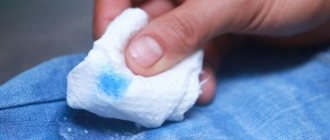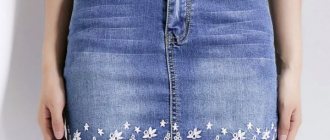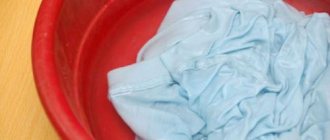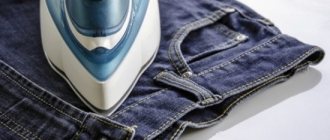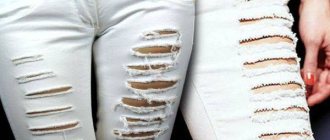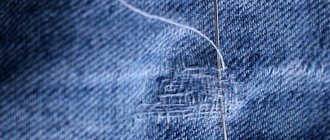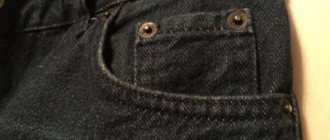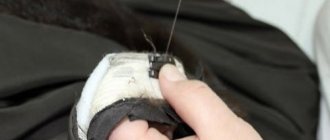Currently, jeans are extremely popular. Every person probably has this item in their wardrobe, because this type of pants is universal. You can wear jeans to almost any event; they will add style to your look. It is important to choose quality trousers and care for them properly. Due to frequent wear, jeans lose their original appearance and stretch. We need to understand the causes of this problem and find ways to solve it.
Where do jeans most often stretch?
The quality of denim affects its ability to stretch. When the first jeans appeared, fashionistas didn’t even pay attention to it.
Over the years, denim pants began to be made from woven cotton. Twill weaving threads are considered to be of the highest quality. But manufacturers are trying to add artificial fibers to reduce the cost of products.
During wear, many jeans stretch so much that they spoil the appearance of their owner. Most often they stretch on the knees, in the buttocks area, and on the waist. Not knowing what to do with them, many people put them in the closet. Don't give up your favorite type of clothing.
Types of denim and its ability to stretch
The first jeans were made from dense, hard and rough canvas called denim, so fashionistas of that time did not think about stretching things. Over the years, the denim industry has switched to using cotton, which, as you know, also comes in different varieties. First of all, jeans fabric is divided into several types depending on the manufacturing method. The best method is considered to be special twisting of fibers using ring spinning machines. This weaving is called twill and is of the highest quality.
The second manufacturing method is faster: the threads are simply intertwined with each other using rotary pneumomechanical machines. Of course, this fabric is inferior in density and quality to standard twisted denim.
The quality of a material is also easy to determine depending on its origin. The following manufacturers are mainly known:
- Barbados – cotton from this country is soft and shiny. Due to the very high price, it is rarely found on sale.
- Mexico - Cotton is made from long fibers, which allows the material to remain smooth and without a single rip.
- India and Asian countries are the most common and affordable type of cotton, which is why it is found much more often than others.
Why do jeans stretch?
There are many reasons for this problem:
- Pure cotton jeans have a lot of stretch due to the fiber structure.
- The composition of lycra in budget samples is higher than acceptable and also becomes a problem. Elastane threads not supported by cotton fibers burst, causing stretching.
- Wearing one model for a long time leads to stretching of the fabric at the knees and sagging in the buttocks area.
- Gentle wash on a delicate cycle for jeans made from low quality fabric. Under the influence of cold water and powder, things stretch.
- Line drying without spinning. Water pulls the fibers down, causing stretching.
How to seat in a certain place?
Fabric conditioner will help restore shape to jeans that have stretched knees, waistbands, or bulging pockets.
What should be done:
- dilute fabric softener with clean water in a ratio of 3:1;
- pour the resulting solution into a spray bottle and carefully treat the stretched areas of fabric on the jeans;
- We place wet jeans in the drum of an automatic dryer or quickly iron the dampened areas with an iron.
The shrinkage effect of denim can only be achieved by drying as quickly as possible. Using the traditional method of drying on a rope under the sun, it will not be possible to achieve the effect of fabric shrinkage.
We shrink jeans in certain areas
Pants often stretch out at the knees. What should you do if your jeans bunch up on your kneecaps? If you don’t have time to wash, but you urgently need to remove the accordion, then you can use a spray bottle.
Pour fabric softener and hot water (1:3) into a spray bottle, shake well to mix, then spray generously onto the stretched area. After this, dry the item on a hot radiator or in a hot dryer. You can even use a hairdryer. Drying at room temperature will have no effect.
The desired effect can be achieved by ironing the “wet” knees from the inside out until they are completely dry. If your jeans hang on your butt, you can use the same method.
A good method: wash without powder in hot water. The fibers will shrink and the pants will take on the desired shape. True, the effect will not last long; you will have to repeat this wash regularly.
Stretched items at the waist are best sutured using a machine. Give it to a workshop or make it at home:
- Unfasten the belt at the intended location.
- Baste the fabric, removing the extra centimeters, sew on a machine, cut off the excess, smooth the seam with an iron.
- Sew the belt into place.
- Steam and iron.
We alter it
If the denim is stretchy or you want to make your trousers much smaller without losing color, you will have to sew them in. If you do not have sufficient experience in sewing, it is better to contact a tailor: the fabric is thick, the cut is quite complex (with stitching, with inset pockets, with loops and a label on the belt, etc.). Using a household machine, shrinking jeans is a task of medium to high difficulty.
Sew on the sides
If the jeans are too big along the entire length, then it is better to narrow them along the side seams. In most models, they are not reinforced with finishing stitching (except for a small area next to the pocket). Therefore, it is quite easy to perform such work without disturbing the original appearance of the product. You will only have to first remove the metal rivets on the pockets (if necessary).
Instructions:
- Do a fitting and use pins to outline how wide the finished jeans should be.
- After removing the trousers, turn them inside out and, in the places secured with pins, make chalk marks where the machine stitching will take place. On the waistband, mark with chalk where it joins the side seams.
- Remove the pins, undo the side loops, undercut the belt 10 cm on both sides of the side seams, also undercut the finishing stitching on the bottom of the product (if the jeans are narrow, it’s easier to remove it completely and then make a new one), remove the finishing stitches on the side seams (if they are available).
- Turn the product inside out and iron the side seams to mark the new seam lines more accurately.
- Draw a line for the new seam using the chalk marks using a ruler. Then match the side seams of both legs. First, pin them along the seams, and then along the intended line of the future stitch, which is repeated on the second trouser leg according to the pin marks.
- In the belt, from the pre-designated points of its connection with the side seams, step back the same distance to the left and right (for example, 2 cm, if you need to sew in 4 cm), draw lines along which the parts of the belt will be sewn, then add seam allowances of 1 cm and trim off the excess.
- Baste the product along the marked lines and try it on. If necessary, adjust the seams and, when the product fits the figure normally, sew them on a machine.
- Trim the finished seams by trimming 1.5 cm along the edges, then finish the edges with an overlocker or zigzag.
- Place a finishing stitch on the side seams next to the pockets, and hem the bottom of the trousers.
- Sew together the details of the belt, sew it at the waist, restore the stitching, and sew on the belt loops.
In this way, it is possible to alter the product by 2-3 sizes without any special disruptions in the cut. If there is a larger difference in size, you will need to rip out all the seams and cut out the parts according to the patterns corresponding to the required size.
How to sew along the middle back seam
If you need to reduce jeans by a size only at the waist, then it is better to do this by sewing them along the back seam and in the waistband. It is necessary to prepare threads not only to match the color of the fabric, but also to be as similar as possible to restore the finishing stitch.
Work sequence:
- Make a fitting, marking with pins along the back seam and waistband how much you need to narrow the pants.
- Undo the back loop, then the waistband 10 cm on both sides from the back seam.
- Open the middle seam by 8-15 cm, so that the new line of the back seam smoothly transitions into the factory one. The more you need to sew, the longer the seam will need to be opened.
- In the waistband, mark a line with chalk at the junction with the back seam, then from this point in both directions mark half of the excess volume (if you need to remove 4 cm, then add 2 cm in both directions). Draw chalk along the marks of the stitching line for the belt parts, and then make seam allowances of 1 cm from them and cut off the excess.
- Using pins, mark a new back seam line with chalk, make a basting, try on the trousers and, if everything is fine, sew along this line.
- After joining the back seam, cut off the excess, leaving an allowance of 1.5 cm and overcast the edge using an overlocker or zigzag.
- Then perform a finishing stitch on the seam, sew on the belt and loop.
If you need to significantly reduce the waist of your jeans, then it is better to do this evenly, distributing the extra centimeters also along the side seams, so as not to disturb the cut. Then you will have to do the same work with the side seams, but the item will fit the figure better.
In most cases, shrinking jeans in different ways is quite possible at home. To do this, you need to choose the right option and follow all the recommendations.
How to reduce all jeans size?
You can reduce jeans size by washing them when they are stretched. But simple washing will not help; you need to know some nuances:
- Select the washing mode when heating the water to 90 degrees. Only exposure to hot water can reduce your pants size. Turn your jeans inside out.
- Washing should last at least an hour. When washed for 30 minutes, shrinkage will not occur.
- Use gel as a detergent; it damages fabric less.
But washing at 90 degrees also has its disadvantages. Denim pants can fit even 2 sizes not only in width, but also in length. And after a week, when worn every day, the item will again take on a stretched look.
It has been noticed that after hot processing, the fabric of the pants becomes rougher and it is difficult to put them on the body. The color also becomes paler. To soften the fabric, add conditioner when washing.
If the fabric contains a lot of synthetics, then after a hot wash the jeans may stretch even more and lose their shape.
If you dry your jeans properly, they can become the size you need. How to return things to their original shape by drying them? Washing machines have a drying program with a powerful cycle. After hand washing in hot water, put the jeans in the machine on the strong setting.
Another way: hang wet jeans on a hot, but not ribbed radiator. Why hang on a smooth battery? The ribbed surface of the battery will leave stretched areas on the fabric.
The heat will help the fibers shrink, causing the jeans to shrink by one size. But the effect will only last a couple of days, but the fabric will remain of the same quality.
Hot drying and downsizing jeans
If your jeans have stretched after washing, then what to do in this case is not so difficult to understand: you can help the jeans shrink with proper drying. The first method is the most banal: squeeze the jeans as hard as possible so that not a single drop remains on them, which would flow down and pull the fabric down, and hang it on a dryer or even on a hot radiator. The item is guaranteed to shrink by at least one size. The second method is more suitable for thin and delicate fabrics: a piece of fabric that absorbs water well is laid out on a horizontal surface, jeans are placed on top, unfolded, and another piece of the same moisture-absorbing fabric is placed as the third layer. Jeans sandwiched between two layers cannot stretch under the weight of flowing water, so they shrink a little in size, or at least do not stretch. The third method is incredibly simple: you need to place the jeans in a washing machine equipped with a hot drying function and set the desired program. The effect will be the same as in the previous two methods.
Wash in hot water
If you wash your jeans in boiling water, you can reduce them by one size. Washing things by hand in hot water is a rather dangerous procedure.
To perform this manipulation, first put cotton gloves on your hands, then rubber ones. Then take 2 basins, pour boiling water into one basin, and cold water into the other.
Then soak the product for 30 minutes in hot water, and then transfer it to cold water. Do this movement 3 times. Contrast soaking works well to secure the tapered shape of denim items.
Methods for shrinking jeans
If you dry your jeans correctly, you can not only shrink them, but also maintain their shape for a long time. There are several ways to dry denim pants:
- After machine washing, lay the pants on the fabric and wait until they dry. Only this option is suitable in the winter or summer, when the air in the house (or other place where drying is planned) is very dry.
- Hang washed and thoroughly wrung trousers on a clothesline only so that they are not pulled out.
- Radiator. A good method, but only in cases where the batteries are clean and have uniform ribs. If the radiator has a complex design with multiple bulges and indentations, then the jeans will also become deformed.
- Machine drying. The option does not require unnecessary comments and notes; after washing, you just need to select drying in the washing machine menu and wait for the result.
Jeans will only shrink if they have been dried artificially. In the air, the moisture will simply evaporate from them, but the size will remain the same.
Enterprising housewives have come up with and tried a lot of ways to reduce excessively stretched jeans.
It is known that when there is a sharp change in temperature, natural fibers shrink greatly. Wool, cotton, silk, and linen inevitably shrink after washing. And if you immerse the product alternately in hot water and then in cold water, you can easily reduce your jeans by 1-2 sizes.
Hand washing is the safest, gentlest way to shrink jeans. It is used for clothes made from stretch or chambris.
In order for a thing to shrink in size and retain its new appearance forever, the following work must be done:
- Immerse the product in hot water (60°C) for half an hour.
- Wash denim pants or shorts as usual, adding a little powder.
- Rinse in very cold (preferably ice) water. To achieve a sharp drop in water temperature, you can pour ice from the freezer into a basin.
Dry the product on a horizontal surface in a ventilated area.
Machine washable
The method of shrinking jeans using a washing machine is suitable for durable fabrics that contain more than 70% cotton. If they are synthetic or thin summer jeans, the pants may stretch even more.
The product should be washed as follows:
- Set the maximum possible water temperature (90°C).
- Add gel and fabric softener to the detergent compartment.
- Start the cotton wash program.
- It is better to dry in an automatic dryer at maximum temperature. If this is not possible, hang the jeans outside in a sunny place.
Slightly damp jeans can be dried with an iron so that they shrink a little.
To make jeans shrink in size, you need to fill the bathtub with hot water and immerse the product in it in a straightened form. If you add gel or washing powder to the water, you can solve two problems at once: remove old dirt and reduce the size of your panties.
After washing, the dirty water is drained, and the jeans are rinsed without removing them from the bath and filled with hot water again. As soon as the water has cooled, the item is wrung out and hung to dry.
A simple and effective way to make jeans shrink in size is by alternating cold and hot water. The pants are placed in a basin and filled with hot water. The water temperature should be as high as possible for the type of fabric from which the product is made. As soon as the water has cooled a little, pour it out and fill the basin with cold water. The procedure is repeated 5–7 times.
Boiling
Clean, thick cotton can be boiled. The boiling method is suitable for denim and gin jeans.
You can weld your pants to make them smaller like this:
- Turn the product inside out.
- Boil water in a large saucepan and submerge the jeans in the boiling water.
- Cook over medium heat for half an hour.
- Using special tongs, remove the product, wait until it cools down, and hang to dry.
An extreme method for those who want to narrow their jeans so that they fit like a glove. The essence of the method is as follows: put on trousers and sit in a bath with hot water.
When the water cools down, you can get out of the bath, but the torment doesn’t end there, since now you’ll have to dry your jeans on yourself without taking them off. It is better to do this in a sunny clearing, exposing one or the other side to warm rays for uniform drying.
Often, jeans only stretch in certain areas, such as the knees or waistband. In this case, it is not necessary to wash the entire product. Deformed fibers can be restored to their previous appearance through local processing. To do this, pour warm water mixed with conditioner into a spray bottle and spray it onto the problem area, trying to wet the fabric thoroughly. The wet areas are then dried using an iron or automatic dryer. When drying in the usual way, this effect cannot be achieved.
The faster a washed item dries, the more likely it is that it will shrink in size. The fact is that during normal drying, which lasts more than 10 hours, the fibers have time to straighten and fully recover. With rapid drying, there is a sharp reduction in fibers and the space between the threads without the possibility of recovery.
Dry clothes prepared for shrinking as follows:
- hang it near heating radiators or a stove, and in summer - in a sunny place;
- for greater effect, place a fabric under the product that absorbs moisture well;
- use a dryer.
To prevent the trousers from shrinking during drying, they are hung with clothespins.
Soaking in boiling water
Tightening the shape by boiling is a fairly simple way. If you add powder and bleach to the water, you can bleach your pants in the right places.
Pour water into the boiling tank, immerse the jeans, and bring to a boil. Using wooden tongs, immerse and turn the product in boiling water. “Cook” it for about 20 minutes, no more is needed, otherwise you can ruin the accessories.
It should be remembered that things shrink equally in both length and width. Therefore, buy long trousers that can be cut to the desired length at the bottom after washing.
Important! The fabric of the product must be of high quality, otherwise the item can be ruined forever.
If stretch jeans are stretched, then the boiling method will not work for them.
Products marked Shrinktofit generally shrink only after the first wash, so it is difficult to restore them. Please take this into account when purchasing. The method of washing in cold water and drying in fresh air is not suitable for reducing the size of such jeans.
“Varenki” - boiling to reduce the size of denim items
What should you do if your jeans are stretched a lot and you need to reduce the item not by one, but by two or three sizes? The old fashioned method of boiling will help with this. In the 70s of the 20th century, boiling with washing powder allowed fashionistas and fashionistas to bleach jeans in different places and adjust them to fit if necessary. The method is simple and unsophisticated: place jeans in a large saucepan with boiling water (it is better to use wooden tongs, which are very convenient for evenly immersing jeans in water, stirring during the cooking process and pulling the item out into the air) and allow them to boil for 20-30 minutes, depending on the desired effect. The precautions for this method are the same as for washing in hot water. The quality of the material must be high, because there is a risk of damaging the color and fittings of the product.
Ironing
What can I do to avoid stretching? All products are not suitable for wet ironing. Even well-fitted items will stretch again.
Instead of ironing, you can shrink it to size by smoothing it with your hands on the fabric:
- Soak denim pants in hot water.
- Lay a piece of fabric that absorbs moisture well on a horizontal surface. You can use a terry sheet.
- Lay the jeans on the fabric, smoothing them with your hands.
- Press the second piece of fabric on top.
- The item will not stretch as the fabric will absorb moisture.
If all else fails, you can simply alter your jeans
Reducing the size of jeans using a needle and thread is a universal way, the fabric will not be damaged. And you can use it even if your stretch jeans are stretched, and it’s not clear what to do, because it’s very difficult to give them the desired shape with water. You can take your jeans to a sewing workshop or use the video instructions below and stitch the denim trousers in the right places yourself.
In fact, there are many more ways to give the desired shape to a stretched denim product, but the material provides only the simplest and most effective answers to the question: “What to do if your jeans are stretched?” But it is better to always remember that this problem can be avoided by buying quality items of the right size.
Reducing a specific area
«»
In order not to have to worry about reducing the size of this wardrobe item, it is better to buy tight stretch clothes.
A slight deformation will also be visible. After washing, elastane will shrink the denim and the trousers may lose their original shape.
If your jeans gather unattractively at the knees or around the buttocks, then you can use a non-standard method of shrinking stretch models:
Put on your pants and fasten the zippers and buttons.
Fill the bath with hot water and sit in the bath wearing your trousers. Sit until the water cools, and then go out into the sun and dry off.
Experts recommend not to bother yourself with narrowing your jeans. Buy pants that zip up tightly. It is much easier to space them out than to achieve the required size using the narrowing method.
Tips and tricks
There are some nuances and restrictions in washing for the purpose of shrinkage, observing which, it will be possible not only to reduce the size of the product, but also to maintain its respectable appearance:
- Jeans decorated with embroidery, rhinestones, and lace should not be boiled or washed intensively;
- as the width of the trousers decreases, the length of the product will also decrease;
- jeans made of stretch material should be taken a size smaller;
- To prevent jeans from stretching, you need to choose high-quality denim or gin and follow the washing and drying rules indicated on the label.
If your favorite jeans are stretched out a lot, and there is no desire or opportunity to buy new ones, you can try to revive the item using the above methods. In case of failure, you can only rely on the services of the studio.
Using these recommendations, you will keep your denim trousers in decent shape for a long time.
Knees stretch out on jeans, trousers: what to do
How to avoid such an unpleasant and unsightly phenomenon as the appearance of a blistering, elongated knee on jeans and trousers? Folds, wrinkles, and even more so bubbling fabric on the knees look careless and are a real horror for absolutely everyone who cares about their own appearance and the impression they create on others. If you're disgusted by wearing trousers or jeans in public that have become baggy at the knees or buttocks - the areas where the fabric is most constantly and heavily stretched, read the following expert advice that can help you get to the root of the problem and forget about blistering knees once and for good!
Why do knees stretch out on jeans and trousers?
All jeans (and trousers) stretch as much as possible in the knees and buttocks. Moreover, the better the fit of the trousers, the higher the likelihood that with intensive wear the fabric will become baggy, wrinkled, knees will appear on the trouser legs, and the butt will sag. The problem of baggy or wrinkled knees on trousers and jeans appears due to the fact that this item of clothing is made from a fabric consisting of only 1–2% flexible material (elastane) and 98–99% cotton/wool. Every time you sit down, you put frequent stretches on the knees and the “butt” of your pants, and when you stand up, that 1-2% of flexible material does not immediately return to its original shape, it takes time. Wrinkles, folds, bubbles, elongated knees are smoothed out over a certain period of time, but depending on how many seasons your trousers and jeans
how long and how you sat (many, for example, like to cross their legs or generally bend their knees as much as possible and tuck them under themselves)... This process can drag on longer and longer, until even washing and sagging can’t help and permanently elongated knees and a saggy “butt” will appear on your trousers. And at this moment you should decide for yourself that the time has come to purchase a new pair! How to make your trousers last longer and maintain an attractive shape?
What to do if your knees are stretched out on trousers or narrow jeans
- Wash your trousers in cold water and let them dry and relax under their own weight.
- If there is no way to wash your trousers, spray the blistering areas (knees, butt) with water and vinegar, shake and hang to dry, you can try to slightly weight the trouser legs with small weights so that the fabric straightens out better. If that doesn’t help, you can try ironing out the bubbles on your knees with vinegar and water.
- Tuck your trouser legs into your shoes or boots. If you have knees or unwanted folds on your jeans or trousers, but you don’t really plan to sit down in them for a long time, tuck the trouser legs into shoes or boots with a narrow and tight top - it will provide sufficient tension to the fabric and eliminate the appearance of bubbles on the knees.
What to do to prevent knees from stretching out on trousers and narrow jeans
- When you sit down, pull your pant legs up slightly so that your kneecap isn't pulling on the same area. This should help reduce the bags that appear over time.
- Wear a belt, especially if your trousers or jeans are loose at the waist. When moving or sitting, trousers that are loose at the waist may slide down onto the hips. When this happens, more tissue collects on the knees and they begin to wrinkle and blister.
- Do not wear pants when they are wet or damp if the fabric has become wet or damp due to rain or high humidity. Try not to sit in wet trousers, or at least not to bend your knees too much when sitting - when wet, the fabric stretches more, and when it dries, it tends to retain the shape it has taken all this time.
- Wash your pants frequently and allow them to sag and dry properly, straightening out under the weight of the wet material. Do not iron them until they are washed; you will iron dust and dirt in them, risking an unsightly shine on the fabric.
- Pants must be washed in cold water. Any item of clothing, including trousers, can shrink due to exposure to hot water. Heat damages most organic fabrics, causing clothing items to “lose” in size. Unfortunately, jeans
are no exception, and if you regularly wash your jeans in
hot water
, they will shrink. - If your trousers are made from a fabric containing wool - tweed, herringbone, etc. You can be saved from wrinkles and blisters on the knees by a lining cut along the side (across) and narrowed at the knee level by 0.5-1 cm. It can be sewn into ready-made trousers at almost any time or, if you are planning to get these, order trousers from a tailor with lining. It must be remembered that the lining is cut in accordance with the detail of the front of the trousers, but 15-20 cm shorter from the bottom. How does the lining save trousers? The fabric with six in it simply slides higher or lower on the lining and does not stretch.
What trousers to buy so that they don’t stretch out at the knees or on the “butt”
- Size is important - trousers and jeans should fit like a glove from the very beginning (given that the material tends to stretch over a certain period of time, it is advisable to measure trousers a size smaller). Just don’t buy jeans and trousers that don’t fit as they should in the store, that are blistered, wrinkled, etc.
- The material your jeans/pants are made from will affect how sensitive they are to knee bend and butt stretch. Therefore, make a choice in favor of very high-quality, expensive fabric (the greedy person pays more), denser material, with a high percentage of elastane.
- The cut of your trousers is also important. Very narrow models (skinny, pencil, cigarette/pipe, chinos) are more likely to stretch out and gather at the knees than trousers with a looser cut.
- And here you should decide for yourself whether to buy fitted trousers to highlight the slenderness of your legs, and then carefully watch to ensure that they do not develop a sprained knee, or to give preference to looser models and not bother yourself with all these hassles.
What are stretch marks and where do they come from?
dr-dib-dermatologue.specialiste-esthetique.fr
Stretch marks (also known as stretch marks) are not very pretty purple, pink or white sinuous stripes on the skin. They are not noticeable, but create an uneven tone. Because of this, the skin even on the most toned tummy or perfected thighs looks loose and flabby.
Stretch marks appear when one or another part of the body quickly increases in volume. For any reason. Here are the most common:
- pregnancy and the accompanying growth of the abdomen;
- breastfeeding - it is not uncommon for the bust to become 1-3 sizes larger;
- sudden weight gain;
- excessive bodybuilding exercises, which causes muscles to rapidly increase in size;
- the rapid growth spurts that some teenagers experience during puberty;
- regular use of drugs containing corticosteroids (they are used, for example, in Itsenko-Cushing disease or Marfan syndrome).
We suggest you familiarize yourself with How to remove mold from fabric: how to remove stains on clothes and shoes
Normally, collagen and elastin are responsible for the skin's ability to stretch and contract. But if for some reason (hormonal, genetic, etc.) these proteins are not enough, problems begin.
The middle layer of skin - the dermis - simply tears, like a paper bag that is trying to be pulled over a larger thing. The tears are healed with connective tissue. As a result, atrophic scars are formed. They are called stretch marks.
Like any scar, it is almost impossible to permanently get rid of stretch marks. Damaged skin, permeated with areas of connective tissue, will never return to its original state. But the right care and certain procedures can make stretch marks almost invisible.
